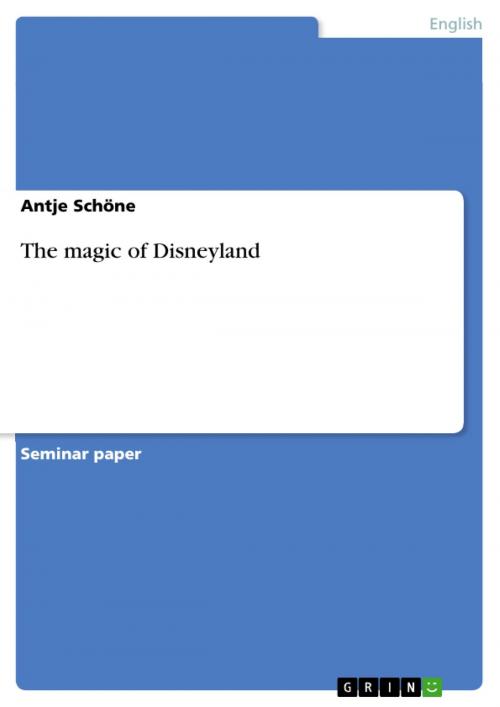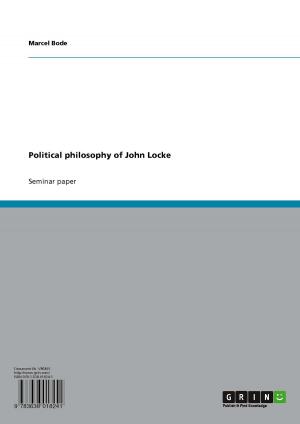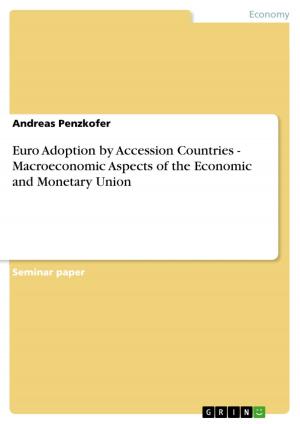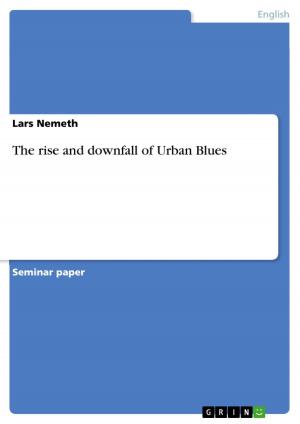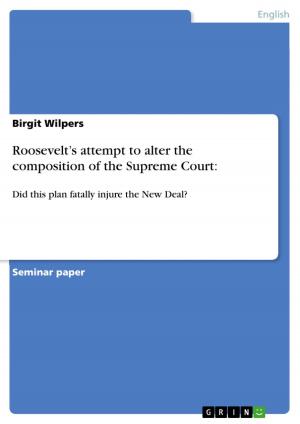| Author: | Antje Schöne | ISBN: | 9783638065573 |
| Publisher: | GRIN Publishing | Publication: | June 19, 2008 |
| Imprint: | GRIN Publishing | Language: | English |
| Author: | Antje Schöne |
| ISBN: | 9783638065573 |
| Publisher: | GRIN Publishing |
| Publication: | June 19, 2008 |
| Imprint: | GRIN Publishing |
| Language: | English |
Seminar paper from the year 2006 in the subject American Studies - Culture and Applied Geography, grade: 2,3, Dresden Technical University (Institut für Anglistik/ Amerikanistik), course: Basic Readings in North American Cultural Studies, 9 entries in the bibliography, language: English, abstract: Introduction Walter Elias Disney is the 'most influential American of the twentieth century' and has become a myth. He created an empire on a cartoon mouse and everything in this empire carries his signature. For his achievements one could call him the founder of postmodern America, a founder of an industry of fantasy that enriched the western culture. That it why the first part of my essay deals with him and his company. The main part is about one of his greatest realizations - Disneyland. Today, this amusement park is one of the biggest tourist attractions in the whole world. Walt Disney brought to this theme park 'all the skills and showmanship he had learned in three decades as a film maker'. He wanted to bring his Disney vision into material and physical existence, as well as providing a strong dose of American ideology. Disneyland represents the American dream - a world of magic and illusion, prosperity and happiness. It is a showcase for postmodernism and the embodiment of capitalism. But what makes Disneyland so magical. Why are so many people visiting this amusement park? After dealing shortly with the history and architecture of the park I will try to explain the success, the magic and the contradictions of Disneyland. Walter Elias Disney was born in 1901 in Chicago, Illinois. In 1906, his family moved to a farm in Missouri and in 1910 they moved to Kansas City. Soon it became visible that Walt Disney was interested in movies, especially of Charlie Chaplin, and drawing. After he left school at the age of 16, he became a volunteer ambulance driver in World War I where he served as a member of the American Red Cross Ambulance Force in France until 1919. After this experience he worked as an advertising cartoonist and started working on methods to perfect the combinations of animation and life action. Walt Disney started some business but with not much success. In 1923 he and his brother Roy Disney launched the Disney Brothers Studio with saved and lent money: 'They bought a used camera, rented a tiny studio in the back of a real-estate office, moved into a one-room apartment together, hired a couple of assistants, and according to Walt began the process of making 'the name Disney famous around the world''.
Seminar paper from the year 2006 in the subject American Studies - Culture and Applied Geography, grade: 2,3, Dresden Technical University (Institut für Anglistik/ Amerikanistik), course: Basic Readings in North American Cultural Studies, 9 entries in the bibliography, language: English, abstract: Introduction Walter Elias Disney is the 'most influential American of the twentieth century' and has become a myth. He created an empire on a cartoon mouse and everything in this empire carries his signature. For his achievements one could call him the founder of postmodern America, a founder of an industry of fantasy that enriched the western culture. That it why the first part of my essay deals with him and his company. The main part is about one of his greatest realizations - Disneyland. Today, this amusement park is one of the biggest tourist attractions in the whole world. Walt Disney brought to this theme park 'all the skills and showmanship he had learned in three decades as a film maker'. He wanted to bring his Disney vision into material and physical existence, as well as providing a strong dose of American ideology. Disneyland represents the American dream - a world of magic and illusion, prosperity and happiness. It is a showcase for postmodernism and the embodiment of capitalism. But what makes Disneyland so magical. Why are so many people visiting this amusement park? After dealing shortly with the history and architecture of the park I will try to explain the success, the magic and the contradictions of Disneyland. Walter Elias Disney was born in 1901 in Chicago, Illinois. In 1906, his family moved to a farm in Missouri and in 1910 they moved to Kansas City. Soon it became visible that Walt Disney was interested in movies, especially of Charlie Chaplin, and drawing. After he left school at the age of 16, he became a volunteer ambulance driver in World War I where he served as a member of the American Red Cross Ambulance Force in France until 1919. After this experience he worked as an advertising cartoonist and started working on methods to perfect the combinations of animation and life action. Walt Disney started some business but with not much success. In 1923 he and his brother Roy Disney launched the Disney Brothers Studio with saved and lent money: 'They bought a used camera, rented a tiny studio in the back of a real-estate office, moved into a one-room apartment together, hired a couple of assistants, and according to Walt began the process of making 'the name Disney famous around the world''.
